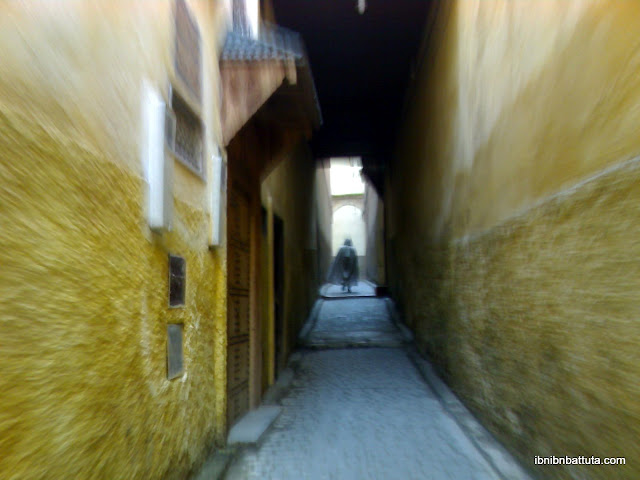In Zemrude, A Revelation About Fes
 |
| A hooded figure sweeps through Derb Serraj in Fes's old medina. |
Fes?! A romantic getaway? At first that announcement bewildered me. Then I began to wonder, Why do I see this city so differently from this magazine's editors and lovestruck readers?
The gap between the Fes I find when I walk out my door, and that which a young honeymooning couple might encounter is at least partly in the attitude. As with any destination, Fes can to some extent be what you make of it. If you arrive expecting the city that the travel magazines and
brochures pitch ("walk into a mystical walled city, as old as time, filled with rich silks and exotic spices... bla bla bla") then that is all you will see—at least for the first few days.
Stay longer, and another city—less timeless, more tarnished—will reveal itself. From my own experience in Fes these last few months, I know this transition to be emotionally withering. What's more, the new jaded outlook it provides can be just as blinding as the romanticized travel mag hype. Frustrated and melancholy, I ventured out less frequently, hustled through the streets with my head down, and immediately mistrusted anyone who spoke to me.
I was sulking through this second, darker stage when a friend lent me Italo Calvino's Invisible Cities. Among the book's peculiar descriptions of place after place, each more fantastic but subtly familiar than the last, one was instantly recognizable:
It is the mood of the beholder which gives the city of Zemrude its form. If you go by whistling, your nose a-tilt behind the whistle, you will know it from below: window sills, flapping curtains, fountains. If you walk along hanging your head, your nails dug into the palms of your hands, your gaze will be held on the ground, in the gutters, the manhole covers, the fish scales, wastepaper. You cannot say that one aspect of the city is truer than the other, but you hear of the upper Zemrude chiefly from those who remember it, as they sink into the lower Zemrude, following every day the same stretches of street and finding again each morning the ill-humor of the day before, encrusted at the foot of the walls. For everyone, sooner or later, the day comes when we bring our gaze down along the drainpipes and we can no longer detach it from the cobblestones. The reverse is not impossible, but it is more rare: and so we continue walking through Zemrude's streets with eyes now digging into the cellars, the foundations, the wells. (Cities & Eyes 2)
I had known for months, of course, that "life is what you make of it" but was simply too disheartened and defeated to act. In reading of Zemrude I saw, at last, how far I had allowed my gaze to sink, and determined to raise it once again—if not to its height at our arrival in Fes, then at least to some middle ground, where no "one aspect of the city is truer than the other."
The heckling may never stop, nor Fes's streets fit my conception of a romantic getaway. But something like acceptance of this place—that third stage, so long in coming—could finally be around the next bend.
